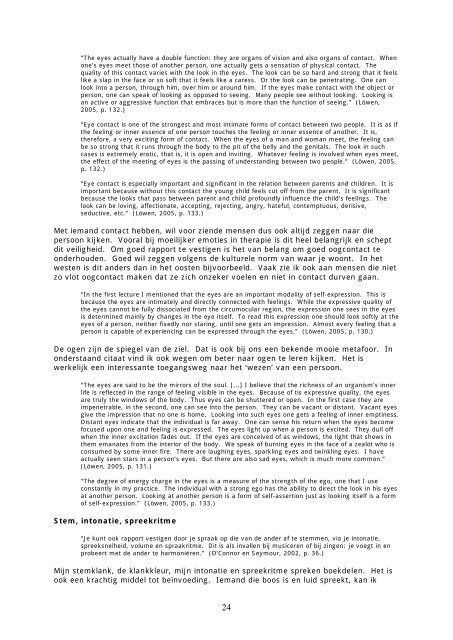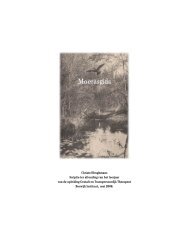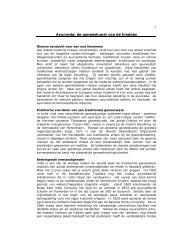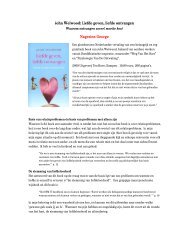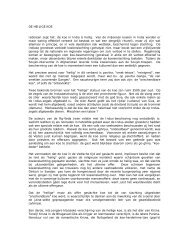De kunst van het vestigen van een diepe rapport - Christel Brughmans
De kunst van het vestigen van een diepe rapport - Christel Brughmans
De kunst van het vestigen van een diepe rapport - Christel Brughmans
Create successful ePaper yourself
Turn your PDF publications into a flip-book with our unique Google optimized e-Paper software.
“The eyes actually have a double function: they are organs of vision and also organs of contact. When<br />
one’s eyes meet those of another person, one actually gets a sensation of physical contact. The<br />
quality of this contact varies with the look in the eyes. The look can be so hard and strong that it feels<br />
like a slap in the face or so soft that it feels like a caress. Or the look can be penetrating. One can<br />
look into a person, through him, over him or around him. If the eyes make contact with the object or<br />
person, one can speak of looking as opposed to seeing. Many people see without looking. Looking is<br />
an active or aggressive function that embraces but is more than the function of seeing.” (Löwen,<br />
2005, p. 132.)<br />
“Eye contact is one of the strongest and most intimate forms of contact betw<strong>een</strong> two people. It is as if<br />
the feeling or inner essence of one person touches the feeling or inner essence of another. It is,<br />
therefore, a very exciting form of contact. When the eyes of a man and woman meet, the feeling can<br />
be so strong that it runs through the body to the pit of the belly and the genitals. The look in such<br />
cases is extremely erotic, that is, it is open and inviting. Whatever feeling is involved when eyes meet,<br />
the effect of the meeting of eyes is the passing of understanding betw<strong>een</strong> two people.” (Löwen, 2005,<br />
p. 132.)<br />
“Eye contact is especially important and significant in the relation betw<strong>een</strong> parents and children. It is<br />
important because without this contact the young child feels cut off from the parent. It is significant<br />
because the looks that pass betw<strong>een</strong> parent and child profoundly influence the child’s feelings. The<br />
look can be loving, affectionate, accepting, rejecting, angry, hateful, contemptuous, derisive,<br />
seductive, etc.” (Löwen, 2005, p. 133.)<br />
Met iemand contact hebben, wil voor ziende mensen dus ook altijd zeggen naar die<br />
persoon kijken. Vooral bij moeilijker emoties in therapie is dit heel belangrijk en schept<br />
dit veiligheid. Om goed <strong>rapport</strong> te <strong>vestigen</strong> is <strong>het</strong> <strong>van</strong> belang om goed oogcontact te<br />
onderhouden. Goed wil zeggen volgens de kulturele norm <strong>van</strong> waar je woont. In <strong>het</strong><br />
westen is dit anders dan in <strong>het</strong> oosten bijvoorbeeld. Vaak zie ik ook aan mensen die niet<br />
zo vlot oogcontact maken dat ze zich onzeker voelen en niet in contact durven gaan.<br />
“In the first lecture I mentioned that the eyes are an important modality of self-expression. This is<br />
because the eyes are intimately and directly connected with feelings. While the expressive quality of<br />
the eyes cannot be fully dissociated from the circumocular region, the expression one sees in the eyes<br />
is determined mainly by changes in the eye itself. To read this expression one should look softly at the<br />
eyes of a person, neither fixedly nor staring, until one gets an impression. Almost every feeling that a<br />
person is capable of experiencing can be expressed through the eyes.” (Löwen, 2005, p. 130.)<br />
<strong>De</strong> ogen zijn de spiegel <strong>van</strong> de ziel. Dat is ook bij ons <strong>een</strong> bekende mooie metafoor. In<br />
onderstaand citaat vind ik ook wegen om beter naar ogen te leren kijken. Het is<br />
werkelijk <strong>een</strong> interessante toegangsweg naar <strong>het</strong> ‘wezen’ <strong>van</strong> <strong>een</strong> persoon.<br />
“The eyes are said to be the mirrors of the soul. [...] I believe that the richness of an organism’s inner<br />
life is reflected in the range of feeling visible in the eyes. Because of tis expressive quality, the eyes<br />
are truly the windows of the body. Thus eyes can be shuttered or open. In the first case they are<br />
impenetrable, in the second, one can see into the person. They can be vacant or distant. Vacant eyes<br />
give the impression that no one is home. Looking into such eyes one gets a feeling of inner emptiness.<br />
Distant eyes indicate that the individual is far away. One can sense his return when the eyes become<br />
focused upon one and feeling is expressed. The eyes light up when a person is excited. They dull off<br />
when the inner excitation fades out. If the eyes are conceived of as windows, the light that shows in<br />
them emanates from the interior of the body. We speak of burning eyes in the face of a zealot who is<br />
consumed by some inner fire. There are laughing eyes, sparkling eyes and twinkling eyes. I have<br />
actually s<strong>een</strong> stars in a person’s eyes. But there are also sad eyes, which is much more common.”<br />
(Löwen, 2005, p. 131.)<br />
“The degree of energy charge in the eyes is a measure of the strength of the ego, one that I use<br />
constantly in my practice. The individual with a strong ego has the ability to direct the look in his eyes<br />
at another person. Looking at another person is a form of self-assertion just as looking itself is a form<br />
of self-expression.” (Löwen, 2005, p. 133.)<br />
Stem, intonatie, spreekritme<br />
“Je kunt ook <strong>rapport</strong> <strong>vestigen</strong> door je spraak op die <strong>van</strong> de ander af te stemmen, via je intonatie,<br />
spreeksnelheid, volume en spraakritme. Dit is als invallen bij musiceren of bij zingen: je voegt in en<br />
probeert met de ander te harmoniëren.” (O’Connor en Seymour, 2002, p. 36.)<br />
Mijn stemklank, de klankkleur, mijn intonatie en spreekritme spreken boekdelen. Het is<br />
ook <strong>een</strong> krachtig middel tot beïnvoeding. Iemand die boos is en luid spreekt, kan ik<br />
24


